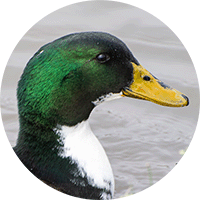Mallard Duck
Appearance: The Mallard is a large and long-bodied duck that is the ancestor of almost all breeds of domestic ducks except the muscovy duck (Cairina moschata). It weighs up to 1.2 kg (2.6 lb) and measures 50-65 cm (20-28 in).
Male has an iridescent glossy dark green head and neck with a narrow white collar. It has a reddish-brown chest, a bright yellow bill, a visible purple-blue wing patch on the flight feathers (speculum) bordered by two white stripes. Gray flanks, short yellow-orange legs and webbed feet. Its tail is black and curled up. The tongue pumps water through the keratinous plates called lamellae that are lined in the bill to sieve food. They may lack the white neck ring, show white on the chest, be all dark, or show oddly shaped crests on the head. Marked sexual dimorphism as the female is mottled brown and has an orange bill marked with black. The female looks as if it belongs to a different species.
Habitat: It inhabits shallow water environment such as lakes, marshes and ponds where it remains as a social resident up to altitudes of 2600 m. Feeds omnivorously on insects, crustaceans, mollusks, and earthworms when breeding, otherwise largely vegetarian. These birds have a renown quacking call.
Breeding: Mating is rather a violent event as with several males chase a single female and then mate with her. The posture consists of 6 to 15 eggs sometimes with a weight equivalent to almost half of its corporal weight. Can live up to 29 years.
Conservation: the Mallard is listed as a species of Least Concern by the International Union for Conservation of Nature (IUCN).
Distribution
The Mallard is a species of duck found in Colombia, primarily as an introduced, non-native species. They exhibit distinct sexual dimorphism, with males displaying vibrant plumage and females having a more mottled brown appearance. Mallards are adaptable birds that can be found in various wetland habitats throughout the country..
Male Mallard: The male Mallard has a vibrant and recognizable plumage. Their head is glossy green with a white neck ring. They have a chestnut-colored breast, grayish body, and a curled black central tail feather. The bill is yellow or greenish-yellow. This striking coloration makes the male Mallard easily identifiable. Female Mallards have a more understated and mottled brown plumage for effective camouflage during nesting. They have a relatively plain appearance compared to the colorful males. Female Mallards have a streaked brown body, a darker bill, and a pale-colored face.
In Colombia, the Mallard is not considered a native or endemic species; therefore, it does not have a specific conservation status within the country.
Taxonomy
- Kingdom: Animalia
- Phylum: Chordata
- Class: Aves
- Order: Anseriformes
- Family: Anatidae
- Genus: Anas
- Species: Anas platyrhynchos
Vocalization
Quack: The mallard's quack is a classic sound associated with ducks. It is most commonly associated with female mallards and is used as a contact call. The quack is a distinctive, nasal, and short sound that is often repeated in quick succession.
Chuckle: Male mallards produce a soft chuckling sound, particularly during courtship displays. It is a low-pitched, rapid, and repetitive vocalization. Males use this sound to attract females and establish their presence.
Whistle: Mallards can produce a whistle-like call, especially when they are in flight. This sound is a high-pitched, clear note that can vary in duration and intensity. It is often heard when groups of mallards take off or land.
Grunt: When mallards are alarmed or threatened, they may emit a grunt-like sound. This vocalization is a quick, low-pitched note that serves as an alarm call. It alerts other mallards to potential danger and is often accompanied by quick movements or flight.












